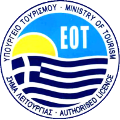Greek cuisine is a blend of indigenous traditions and foreign influences. Neighboring Italy and Turkey have left a major impact on Greek cuisine, and there are shared dishes with both of these nations. The traditional Greek diet is very Mediterranean, espousing vegetables, herbs, and grains native to the Mediterranean biome. Being a highly maritime nation, the Greeks incorporate plenty of seafood into their diet. The country is also a major producer and consumer of lamb; beef, pork, and especially chicken are also popular. Olive oil is a staple in Greek cooking, and lemon and tomatoes are common ingredients. Bread and wine are always served at the dinner table.
The cuisine in Greece can be radically different from what is offered in Greek restaurants around the world. Greek restaurants abroad tend to cater more to customer expectations rather than offer a truly authentic Greek dining experience. One example is the famous gyros (yee-ros), a common item on Greek menus outside Greece. While it is a popular fast-food item in Greece today, it is actually a relatively recent foreign import (adapted from the Turkish döner kebap) and is considered by Greeks as junk food. It is never served in the home and is generally not found on the menus of non-fast-food restaurants.
Eating out is Greece's national pastime and a rewarding experience for visitors; however, not knowing where to go or what to do can dampen the experience. In the past, restaurants that catered mostly to tourists were generally disappointing. Thankfully, the nation's restaurant industry has grown in sophistication over the past decade, and it is now possible to find excellent restaurants in highly-touristed areas, particularly areas that are popular with Greek tourists as well. Thus, it remains a good idea to dine where Greeks dine (Go search them at the times greeks dine: 21:00-23:00). The best restaurants will offer not only authentic traditional Greek cuisine (along with regional specialties) but Greece's latest culinary trends as well. A good sign of authenticity is when you get a small free dessert when you ask for the bill. Bad signs are when desserts are listed on the menue, and also when the waiter is taking your plates away while you are still sitting at the table (traditionally everything is left on the table until the customer is gone, even if there is hardly any space left).










